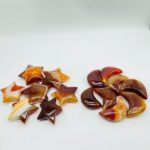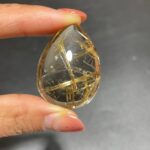Decorative crystal has been a staple in interior design for centuries, adding a touch of elegance and sophistication to any space. From shimmering chandeliers to intricate sculptures, crystal pieces are renowned for their beauty and versatility. In this comprehensive guide, we explore the world of decorative crystal, highlighting its history, types, applications, and tips for incorporating it into your home.

History of Decorative Crystal
The art of crystal making dates back to ancient times, with evidence of crystal objects being crafted as early as 3,000 BC in Mesopotamia and Egypt.
- In the 16th century, Venice emerged as a major center for crystal production, and Venetian glassmakers perfected the techniques of creating clear and colorless crystal.
- The 18th century saw the rise of English crystal manufacturers, such as Waterford Crystal, which became renowned for their high-quality glassware.
- In the 20th century, crystal manufacturing became more industrialized, leading to increased accessibility and affordability.
Types of Decorative Crystal
Decorative crystal can be classified into several types based on its composition and manufacturing process:
Lead Crystal
- Contains lead oxide, which adds brilliance and weight to the crystal.
- Lead crystal is known for its high refractive index, creating a shimmering effect.
- However, lead crystal is relatively soft and can be prone to damage.
Crystal Glass
- Made from soda-lime glass, which is more durable than lead crystal.
- Crystal glass contains no lead oxide and offers a less sparkly appearance.
- It is a cost-effective alternative to lead crystal.
Blown Crystal
- Created by blowing molten glass into a mold.
- Blown crystal is known for its intricate shapes and delicate lines.
- It is often used in the production of vases, sculptures, and decorative figurines.
Cut Crystal
- Involves cutting and polishing the surface of the crystal to create patterns and designs.
- Cut crystal produces a multifaceted look with a variety of light-reflecting surfaces.
- It is often used in the production of chandeliers, sconces, and glassware.
Applications of Decorative Crystal
Decorative crystal finds applications in a wide range of interior design projects, including:
Chandeliers and Sconces
- Crystal chandeliers and sconces are classic lighting fixtures that add elegance and grandeur to any space.
- They come in various styles, from traditional to modern, and can be customized to match the decor.
- Crystal chandeliers and sconces are often used in living rooms, dining rooms, and entryways.
Vases and Bowls
- Crystal vases and bowls are perfect for displaying flowers, fruits, or decorative objects.
- They add a touch of sophistication to any setting and can serve as focal points on tables or consoles.
- Crystal vases and bowls are available in various shapes and sizes to suit different decor styles.
Figurines and Sculptures
- Crystal figurines and sculptures are decorative pieces that add a touch of whimsy or elegance to any space.
- They can depict animals, people, or abstract forms, and come in a range of sizes.
- Crystal figurines and sculptures are often used as collectibles or as accent pieces on shelves or tables.
Jewelry and Accessories
- Crystal is also used in the production of jewelry and accessories, such as necklaces, earrings, and bracelets.
- Crystal jewelry adds a touch of sparkle and sophistication to any outfit.
- Crystal accessories can also include keychains, cufflinks, and hair ornaments.
Tips for Incorporating Decorative Crystal into Your Home
When incorporating decorative crystal into your home, consider the following tips:
Start Small
- If you’re new to decorating with crystal, start with a few small pieces, such as a vase or a figurine.
- This will allow you to experiment with different styles and see how crystal fits into your existing decor.
Choose Neutral Colors
- Crystal pieces in neutral colors, such as clear, white, or black, are versatile and easy to match with any decor.
- Neutral colors allow the beauty of the crystal to shine through without overpowering the space.
Layer Different Types
- Don’t be afraid to mix and match different types of crystal, such as lead crystal, crystal glass, and cut crystal.
- Layering different textures and designs can create a unique and eclectic look.
Use Lighting to Your Advantage
- Crystal reflects light beautifully, so use lighting to enhance its sparkle and brilliance.
- Place crystal pieces near windows or under lights to maximize their impact.
Strategies for Using Decorative Crystal Effectively
To effectively use decorative crystal in your home, consider the following strategies:
Create a Focal Point
- Use a large crystal chandelier or a statement vase as a focal point in a room.
- This will draw the eye and create a dramatic effect.
Accessorize with Sparkle
- Add a touch of sparkle to any space with crystal figurines, jewelry, or other accessories.
- These pieces can help brighten up a room and add a touch of glamour.
Mix with Other Materials
- Don’t be limited to using crystal alone.
- Mix crystal with other materials, such as wood, metal, or fabric, to create a more dynamic look.
Use Reflection to Your Advantage
- Crystal reflects light beautifully, so use it to your advantage.
- Place crystal pieces near mirrors or windows to create a dazzling effect.
Step-by-Step Approach to Decorating with Decorative Crystal
Follow these steps to decorate with decorative crystal like a pro:
Plan Your Design
- Before you start shopping for crystal pieces, create a plan for your design.
- Decide where you want to place the crystal, what style you’re going for, and what color scheme you want to follow.
Shop Smart
- When shopping for crystal, compare prices and quality from different retailers.
- Look for pieces that are well-made and free of imperfections.
Accessorize Gradually
- Start with a few small crystal pieces and gradually add more as you see fit.
- This will help you avoid overdoing it and create a cohesive look.
Pay Attention to Details
- Once you’ve placed your crystal pieces, pay attention to the details.
- Use the tips in this article to enhance the sparkle and beauty of your crystal.
Table: Market Size and Growth of Decorative Crystal
| Year | Market Size (USD) | Growth Rate |
|---|---|---|
| 2022 | $22.4 billion | 4.5% |
| 2023 (projected) | $24.0 billion | 5.0% |
| 2024 (projected) | $25.7 billion | 5.5% |
(Source: Allied Market Research)
Table: Types of Decorative Crystal and their Applications
| Type | Composition | Applications |
|---|---|---|
| Lead Crystal | Contains lead oxide | Chandeliers, sconces, vases, bowls, figurines |
| Crystal Glass | Made from soda-lime glass | Vases, bowls, glassware, jewelry |
| Blown Crystal | Created by blowing molten glass | Vases, sculptures, decorative figurines |
| Cut Crystal | Involves cutting and polishing the surface | Chandeliers, sconces, vases, bowls |
Table: Benefits of Using Decorative Crystal
| Benefit | Value |
|---|---|
| Adds elegance and sophistication to any space | Creates a luxurious and inviting atmosphere |
| Reflects light beautifully | Brightens up a room and creates a dazzling effect |
| Can be used in a variety of ways | From lighting to accessories to sculptures |
| Durable and |




























